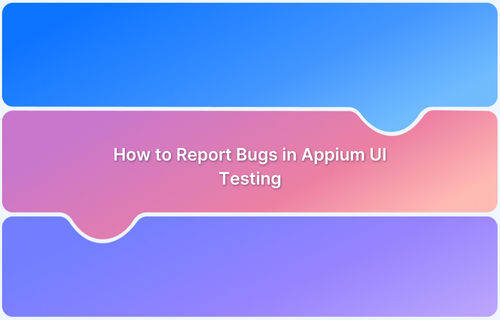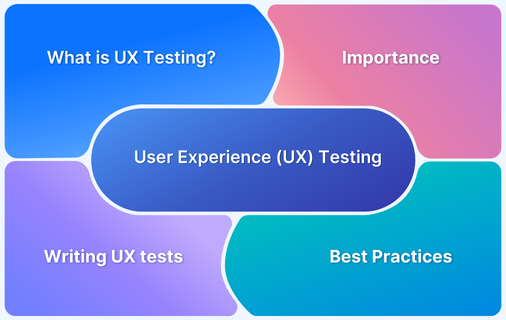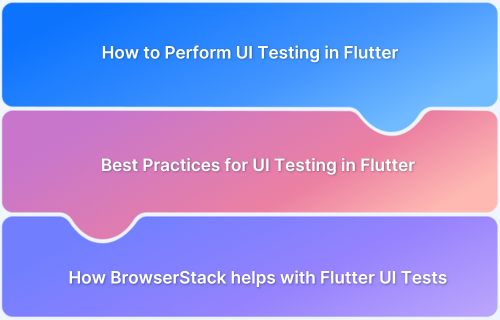Users expect applications to look good and work flawlessly across screens. A broken button or misaligned form can drive users away in seconds. This is why GUI Testing is essential to overcome such gaps.
Overview
Graphical User Interface testing is the process of verifying a software’s graphical user interface to ensure it functions and displays correctly.
Types of GUI testing
- Functional Testing
- Usability Testing
- Compatibility Testing
- Accessibility Testing
This article covers all about GUI or graphical user interface testing, its benefits, challenges and more.
What is GUI Testing in Software Testing?
GUI Testing (Graphical User Interface Testing) is a type of software testing that focuses on validating the visual elements and user interactions of an application. It ensures that the application’s interface—such as buttons, menus, icons, text boxes, and dialogs—works correctly and appears as expected across different devices and screen resolutions.
In GUI testing, testers simulate user actions like clicking, typing, scrolling, and dragging to verify that the interface responds appropriately. This type of testing helps identify layout issues, functionality bugs, and usability problems that could impact the user experience.
Key Goals of Graphical User Interface Testing
The following are some of the key goals of performing Graphical User Interface Testing:
- Ensure UI elements are displayed correctly and consistently
- Validate that user actions trigger the intended application behavior
- Detect visual or functional bugs across platforms and screen sizes
- Maintain a smooth and intuitive user experience
Types of GUI Testing
Here are some of the types of GUI testing:
1. Functional Testing
It determines whether a UI works according to its function requirements. First, you have to specify the functions you want to test. Then you need to determine input data and output as per the requirements. After that, you can execute test cases and compare your actual result to the prior expected result.
If the original and previously determined output matches, it indicates the app’s functions are running as per our expectations. Ex. Textbox allows users to enter the text within it and displays them on the screen. Functional testing checks whether it is happening correctly or not
Learn More: Functional and Non-Functional Testing Checklist
2. Usability Testing
This ensures how easily a user can handle an application. TThe main factors for this graphical user interface testing are-
- Faster access: The response time of the software must be speedy. We have to ensure the software will load within 3-6 seconds.
- Readability: The application layout will be clear, and the content should be simple and user-friendly.
- Satisfaction: To test the users’ satisfaction with the apps’ functions, and offerings.
- Navigation: The navigation steps should be easy. It includes- a search bar, header, footer, and effective internal linking.
- Experience: Ensure the correct error messages are shown. It empowers the usability and user experience of the application.
Pro-Tip: Visual Regression testing streamlines this by checking if new code contradicts or scrambles older features. It ensures that new code enhances or leaves old code unaffected with every build.
3. Compatibility Testing
This testing displays the balance of the app’s design, layouts, and behavior throughout several OS, browsers, mobile devices, databases, hardware platforms, networks, etc. Furthermore, compatibility testing checks if the app can meet the expectations of different OS browsers and devices. This is a robust way to identify bugs before the final product launch.
4. Accessibility Testing
Accessibility testing ensures that all users (including most disabled persons) get entrance and interact with software with its maximum possibility. There are several accessibility criteria for this purpose ex. Accessibility of text and labels, image contrast ratio, navigations, and more. This testing aims to remove barriers to communicating with users who face problems with poorly designed UI.
Also Read: How to Automate Accessibility Testing
Challenges and Limitations of GUI testing
While GUI testing is essential for ensuring a seamless user experience, it comes with its own set of challenges and limitations that can impact efficiency, reliability, and scalability.
- Complexity of GUI systems: Visual noise raises the complexity of a UI system. Unnecessary white spaces and contrast are the cause of this problem. Also, additional elements and functions distract users and result in a poor user experience.
- Maintenance and scalability: Scalability of UI leverages the reusability of a component. That means the design and code should be able to adapt to the changes in features. In this way, maintenance of UI becomes easy. Otherwise, it would be costly to maintain your UI with changing requirements.
- Integration with other testing types: One of the toughest challenges of GUI testing is to perform regression testing. Because code changes bother the regression testing to give the expected output. Another problem occurs in structural testing. It’s a kind of white-box testing that checks if all the components have appropriate test coverage. You will need to design additional tests if there is any coverage gap.
Best Practices for GUI testing
Here are the best practices for GUI Testing:
Test Planning and Design Considerations: Making a test plan before writing test cases is necessary. Test planning emphasizes the principal areas of the UI for testing. Also, it includes-
- Commencement date of testing
- Human resources
- Test environments – mobile, desktop, etc.
- Testing goals that include criteria for measuring success or failure
- Testing techniques- scripted testing, exploratory testing, UX testing, and more.
Test Case development: Start your test case with an accurate description of GUI events like registration. Then execute the test by adding conditions and procedures. Finally, measure the result and compare it with the expected one. The best practices for GUI test cases are-
- Separate the unnecessary test data from your test case. Also, create separate data for the test environment.
- Create individual test cases for different modules. Let’s assume the modules of a shopping app- searching items, filtering items, adding to a cart, and more. So, create individual test cases for them.
- Differentiate positive (valid data) and negative (invalid data) test cases.
Learn More: Test Case Reduction and Techniques to Follow
Test Automation: Automation testing is faster and handles multiple test cases simultaneously. Also, automation frameworks support recording results, screen captures, and several modern features for testing. It allows parallel test execution making it a good option for cross-browser testing.
Why perform GUI Testing on a Real Device Cloud?
Performing GUI testing on a real device cloud ensures that your application’s user interface works flawlessly across the wide variety of devices, screen sizes, resolutions, and OS versions that your users actually use. Unlike emulators or simulators, real devices provide accurate results by replicating real-world conditions such as hardware performance, touch gestures, network fluctuations, and more.
Key Benefits:
- Test on real browsers and devices for accurate UI validation
- Detect layout issues, rendering problems, and device-specific bugs
- Ensure consistent performance across multiple OS and screen configurations
- Scale testing without the cost of maintaining in-house device labs
- Integrate seamlessly with your CI/CD pipeline for faster releases
Using a real device cloud like BrowserStack helps you deliver a polished, consistent user experience, every time, on every device.
Read More: 15 Best GUI Testing Tools
Why Choose BrowserStack for GUI Testing?
BrowserStack Percy and App Percy offer a powerful, all-in-one platform for automated visual GUI testing. They help you catch visual bugs, track UI changes on every commit, and ensure your application’s interface stays consistent across updates and deployments. With BrowserStack, you can streamline visual QA and maintain UI integrity with confidence.
Key Benefits of Using BrowserStack Percy & App Percy:
- Cross-Browser Coverage: Test web apps across real desktop and mobile browsers at multiple screen widths.
- Faster Visual QA: Automate the process of spotting visual regressions—no more time-consuming manual reviews.
- Consistent UI Experience: Catch visual discrepancies early to maintain a smooth, polished interface.
- Seamless Collaboration: Share visual diffs with developers, designers, and QA for quick feedback and faster fixes.
- Regression Prevention: Detect and fix unintended visual changes before they reach production.
- Toolchain Integrations: Easily integrate with GitHub, GitLab, Bitbucket, and other CI/CD tools.
- Quick Setup: Use BrowserStack SDK and Percy SDK for plug-and-play integration into your existing workflow,and get up and running in minutes.
With BrowserStack, GUI testing becomes faster, more reliable, and effortlessly scalable across browsers, devices, and teams.
Conclusion
Make GUI testing a priority to catch visual and functional issues before they reach your users. Actively test your app’s interface across real devices to ensure every button, layout, and interaction works flawlessly.
With the right tools like BrowserStack Percy and App Percy you can speed up Graphical User Interface Testing releases, improve quality, and deliver a smooth user experience.








